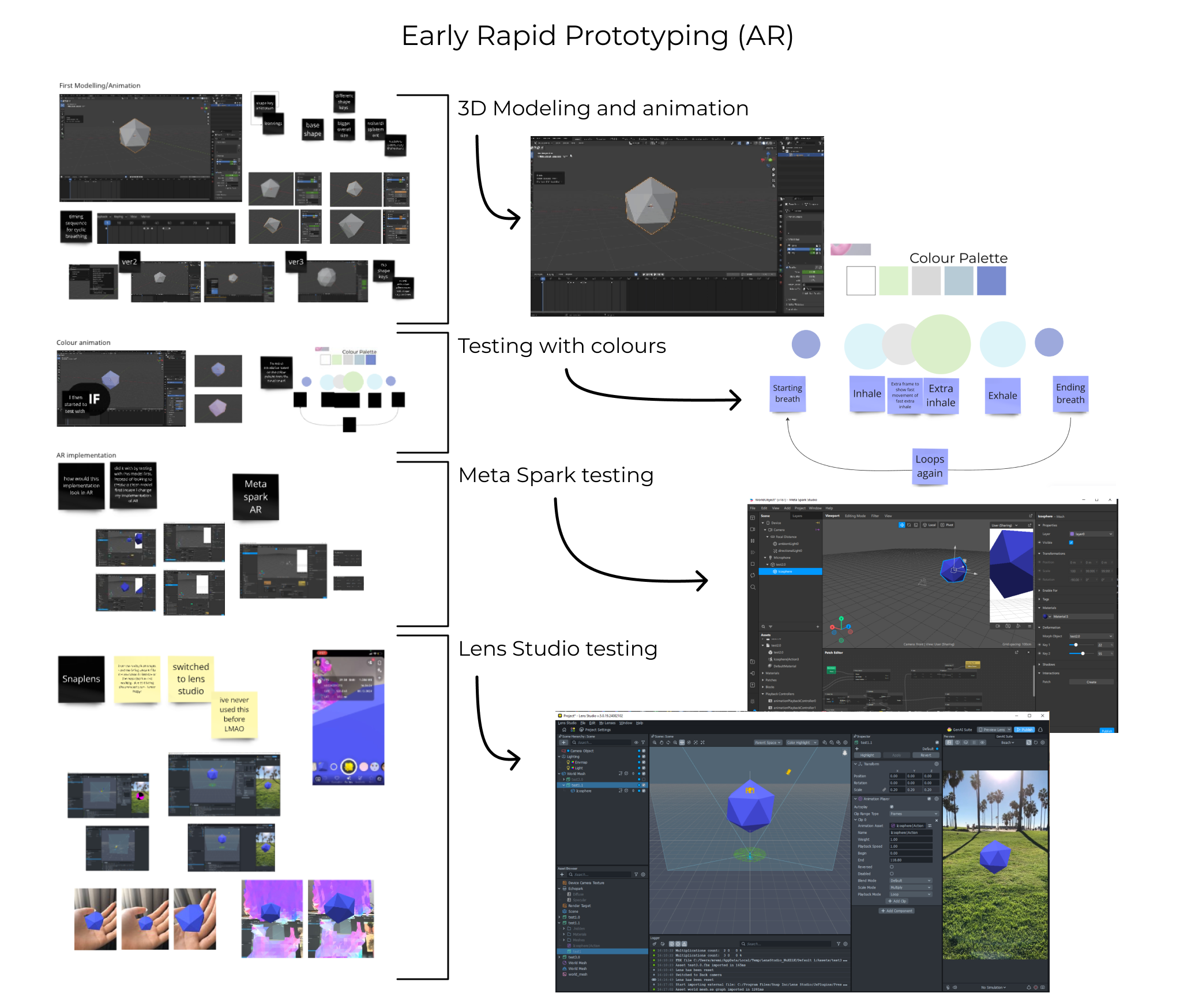Blog 8 | Rapid Prototyping (AR)
Design 302 | Date: 17/09/24 (Tuesday)
This is a small reflection based on what I had done over the inter-semester break, looking into the starting phase of the ideation phase, focusing on rapid prototyping.
What?
I started to do some early rapid prototyping for my project, focusing on one of my concepts had created previously. The rapid prototyping I had done was looking into 3D modelling and 3D animation within Blender and testing how my idea work within AR.
I did a quick key shapes 3D animation within Blender to then import it into a social media AR app to quickly test how it would look in an AR space without having to set up the AR itself within a game engine.
Figure 1.
Graphic of processes of my first rapid prototype.

Note. Authors processes of what they had done for their prototype, screenshots from Blender, Meta Spark and Lens studio. Graphic made by the author.
I had first started off by using Meta Spark to import my animation, as I had previously utilised this program before, however, I couldn't get it to work. As I wasn't sure if my animation was the problem or the program itself, I switched to Lens Studio to test. I had used Lens Studios before, but for a little bit, so I was aware of what it was and how similar in nature it is to Meta Spark. The animation worked within Lens Studio, and so I was able to test my concept within an AR space.
From 3D modelling and animating, I found that I could animate colour, and as such, it would make following the animation easier. However, I also learned that this doesn't export outside the 3D modelling application, and as such, I would need to learn how to do this within the program in which I choose to confide the AR aspect.
So what?
I felt well informed and ready when going into doing rapid prototyping, as I had utilised these technologies before and had some experience with them. However, as I was going through this process, many unexpected things had come up. Namely, Meta Spark was not working with my animation, which I wasn't able to figure out. I also learned through the break that Meta Spark, as a program, was being shut down as a third-party application. As such, If I were to use the program, my outcomes wouldn’t be fully accessible past January 14th 2025. (Meta Spark, 2024)
I learnt that only some things have to be planned and that despite having previous experiences with these programs, things can update and not work accordingly. Having extra time to fully develop and produce my prototype helped ensure that my rapid prototype worked well.
Having tested my concept as a prototype really helped in ensuring I could visualise my final output. I found the animation to be decent and the timing of the breathing to be alright. I was also able to think about whether I wanted to have plane detection, hand detection, or just floating for my AR object. The first two would've been more immersive. However, the last one would alow for the object to always be in the frame and easy to use and see. This would need to be iterated further.
Now what?
In the future, I will need to look into iterating and continue iterating my prototype and changing things such as the type of AR, updating the 3D model and animation, and looking into using a game engine such that an app isn't needed to test the AR filter. I also need to test this concept with users and people within my cohort, looking into whether they find it practical to use and if they feel any discomfort. This would be to test my timings within the breathing technique to see if the timeline and spacing are done effectively. I will look into doing these as I go back into university and am able to easily test with my cohort during studio times and such. I will ensure to write down my findings within my Miro board, noting down any interesting recordings I can find.
References
J, D. (1994). Reflective practice for practise. PubMed, 14(1), 47–50.
https://pubmed.ncbi.nlm.nih.gov/8303152
Meta Spark. (2024, August 27). A Meta Spark Update.
https://spark.meta.com/blog/meta-spark-announcement/#:~:text=Meta%20Spark's%20platform%20of%20third,available%20effective%20January%2014%2C%202025.&text=Following%20a%20thorough%20assessment%2C%20we,Tuesday%2C%20January%2014%2C%202025.
Rolfe, G., Freshwater, D., & Jasper, M. (2001). Critical Reflection for Nursing and the Helping Professions: A User’s Guide. Palgrave MacMillan.
What? So what? Now what? (2020, January 30). The University of Edinburgh.
https://www.ed.ac.uk/reflection/reflectors-toolkit/reflecting-on-experience/what-so-what-now-what